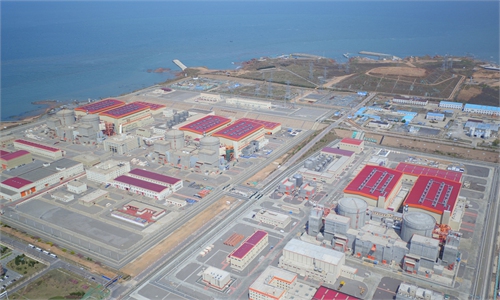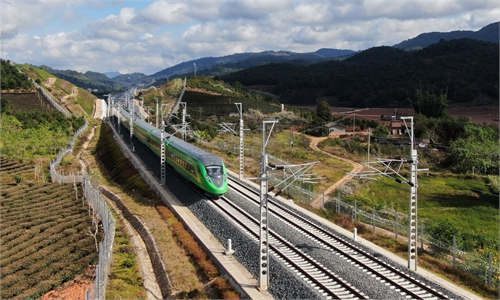2023 TWO SESSIONS / DEPUTIES AND MEMBERS
It is 'necessary' and 'feasible' to build nuclear power plants in inland areas: national political advisors

Flags flutter in the wind at Tian 'anmen Square ahead of the two sessions in Beijing, March 2, 2023. Photo: VCG
Fifteen national political advisors submitted a joint proposal to the ongoing two sessions, highlighting the necessity and feasibility of building nuclear power plants in inland areas, strengthening the development of nuclear power, expanding the spatial distribution of nuclear power and promoting the comprehensive use of nuclear energy for heating.The 20th National Congress of the Communist Party of China views energy security as an important part of the modernization of national security system and proposed to promote carbon peaking and carbon neutrality actively yet prudently and safely develop nuclear power. Yang Changli, a member of the 14th National Committee of the Chinese People's Political Consultative Conference (CPPCC) and chairman of China General Nuclear Power Group, together with 14 other members of the CPPCC National Committee, submitted the proposal.
"China has established a solid foundation for achieving bigger goals and higher quality development of nuclear power," Yang told the Global Times on Sunday. In order to give full play to the strategic value and positive role of nuclear power, efforts should be made to maintain the construction of more than 10 generator units per year in the next decade under the premise of ensuring safety.
The planning and construction of nuclear power projects in areas with insufficient capacity to secure clean base-load power supply and excessive carbon and pollutant emission intensity should be started as soon as possible, said the proposal.
The Chinese mainland currently has 76 nuclear power units under construction, with an installed capacity of 81 million kilowatts, ranking No.2 in the world, according to Yang. However, both the installed capacity of nuclear power generators and the proportion of nuclear power are still small, with 2.2 percent and 5 percent respectively.
To realize peak carbon neutrality, the installed capacity of nuclear power needs to reach at least 150 million kilowatts in 2030 and 380 million in 2050, based on the calculation of 10 percent and 18 percent of nuclear power generation by 2030 and 2050.
"That means we must maintain the development intensity of approving more than 10 nuclear power units per year in the next decade," Yang told the Global Times.
To implement the "dual carbon" strategy, China can no longer increase fossil fuels on a large scale for power generation, Yang pointed out. "In a power system with the increasing proportion of wind, solar and other new energy sources, nuclear power is needed as a stable power source to complement each other with new energy and play a fundamental supporting role."
Nuclear power can fully leverage its comparative advantages of being stable, reliable and suitable to bear the base load of the power grid during the peak hours in summer and winter.
Yang also said that at present, the spatial distribution of nuclear power development in China is not balanced, and all of it is concentrated in coastal areas. Under the new landscape of building a new type of power system and steadily promoting the goal of "dual carbon," it is necessary and feasible to expand the spatial layout of nuclear energy.
According to statistics, 64 percent of the world's nuclear power units are operating inland and 44 percent are under construction inland, and more than half of the units in the US, France, Russia and other major nuclear power countries are in inlands.
As for the safety of inland nuclear power plants, Yang said that the country's planned inland nuclear power plants have sufficient earthquake tolerance and the ability to withstand flood and drought.
"In recent years, the nuclear industry has carried out a large number of in-depth and detailed studies on the main concerns such as water resource security, low-level waste liquid discharge, the impact of serious accidents on river basins, and the feasibility of emergency plans. The conclusion shows that the construction of nuclear power plants in inland areas is technically feasible," Yang said.
In addition to providing electricity, nuclear energy is also widely used in non-electrical fields such as clean heating, seawater desalination and hydrogen production.
On November 1, 2022, China General Nuclear Power Corporation's Liaoning Hongyanhe Nuclear Power Plant officially started operation, making it the first nuclear heating project in Northeast China, benefiting nearly 20,000 local residents.
In addition to the Hongyanhe, the Haiyang Nuclear Power Plant in East China's Shandong Province and Qinshan nuclear power Plant in East China's Zhejiang Province have also demonstrated nuclear heating while ensuring safe power generation, Yang said. The three projects have a total heating area of 5.9 million square meters, reducing standard coal consumption by 140,000 tons and carbon dioxide emissions by 380,000 tons every year.
"The subsequent large-scale promotion will generate huge ecological and social benefits," Yang said.


